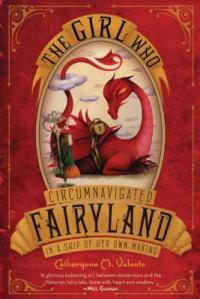 Valente, Catherynne M. The Girl Who Circumnavigated Fairyland in a Ship of Her Own Making. New York: Feiwel and Friends, 2011.
Valente, Catherynne M. The Girl Who Circumnavigated Fairyland in a Ship of Her Own Making. New York: Feiwel and Friends, 2011.
:-)! :-)! :-)! :-)!
I’m always in search of the kind of fun books I read as a kid, so I keep my eyes open (good thing) when I’m re-shelving books in the children’s area, which is how I came across this one. I also like to read fantasy in the springtime, and this seemed like a perfect springtime fantasy read. I guessed correctly. The book fit both bills well, and it’s just clever enough to be unique without trying to be oh-so-clever that it’s over the top and annoying.
I loved it from beginning to end. First of all, we have a heroine rather than a hero here. She isn’t exactly a “fearless” heroine, but I prefer heroines (and heroes) who aren’t. September has her moments of fear, but she is still an incredibly brave, curious character who stands up to villains in a way children’s book characters often don’t. When I was a kid, I was always frustrated by characters who didn’t think very logically and were too easily cowed. Neither criticism can be thrown at September.
I love Valente’s version of Fairyland. She hangs on to key elements of folklore while updating for 21st-century sensibilities. It works, and I’m not quite sure why, because I so often hate it when writers explain away folklore (which they love to do with vampires) by saying things like, “You shouldn’t believe everything you’ve read about us” or “Oh, well, it used to be that way, but 100 years ago, so-and-so invented special glasses (say), and now we can walk around during daylight hours (say).” I laughed, though, when Valente mentioned different cultural interpretations of folklore. Our narrator also inserts herself into the book, in asides to the reader, which is an old-fashioned technique I’ve always appreciated, reminiscent of E. Nesbit (although, if you’re not a fan of those kinds of asides, I can tell you that you probably won’t like this book). Again, she doesn’t do it to the point that it’s annoying, but rather in a “we’re comrades in all this and understand each other” way.
You know me, however, the sucker for good characterization. None of this would matter if September weren’t an intrepid adventurer who asks the right questions, knows when to cry at the right time, and who has a heart. A through L (yes, that’s his name), our Wyvern, is as endearing a traveling companion as you’re likely to meet, without being stupid or treacly. The Marquess is a wonderful Bad Guy, taking on many of the characteristics of today’s so-called “mean girls”. Someone who wasn’t as savvy as September might be fooled into believing the Marquess wanted to be best friends, but September knows she should be weary, sure that behind her back, the Marquess is plotting to have her killed. The Green Wind is a superb character, too, carrying September away to Fairyland. And who could not like Capurna, the fairy who is “accustomed” to carrying on conversations while racing along on a velocipede? Many more lovable characters abound.
One other aspect of the book that charmed me is that Valente, like authors of yore, doesn’t talk down to her readers. She expects us either to know (or to be able to define via context) the “big words” children’s writers tend to shy away from these days. She assumes her readers are familiar with folklore, and, if not, that they just might learn enough from her to pique their interests, encouraging them to read more. Hooray for a 21st-century author who assumes that a child reading her book is smart — because, really, most children are smarter (and wiser) than we give them credit for being.
My only complaint? Why, since there are so many illustrations of so many other things (including the giveaway cover illustration of September holding a key behind her back and looking at the Wyvern and his chained wings), isn’t there an illustration of September’s ship? It should have been on the cover. But that’s a minor (some might even say “childish”) complaint. If you like children’s fantasy, this is a good one.

Leave a comment
Comments feed for this article